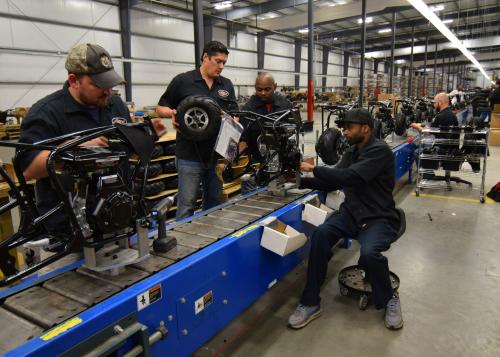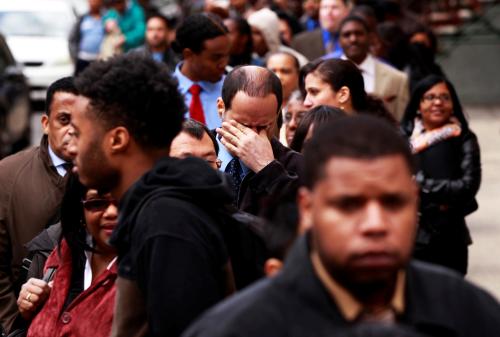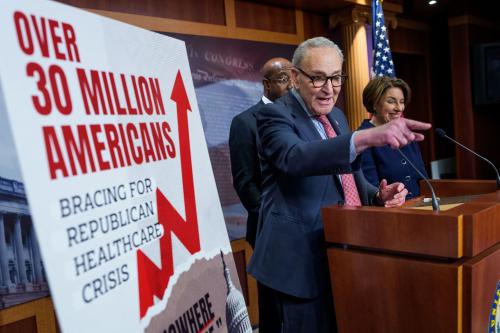Summary
The decline in the labor force participation rate – the number of Americans either working or looking for work as a percentage of the population – is primarily due to the aging population and other structural factors, rather than cyclical weaknesses, and is expected to continue. The finding has implications for policymakers who are grappling with whether the sluggish job market can be improved with government tools, and for the potential growth rate of the U.S. economy through the end of the decade.
In “Labor Force Participation: Recent Developments and Future Prospects,” authors Stephanie Aaronson, Tomaz Cajner, Felix Glabais-Reig, Christopher Smith and William Wascher of the Board of Governors of the Federal Reserve and Bruce Fallick of the Federal Reserve Bank of Cleveland project that the rate will decline to 61 percent by 2022 – a level as low as the early 1970s. The rate has fallen 3 percentage points – from 66 percent pre-Great Recession to 63 percent this year – even as the labor market has shown signs of recovery, with an unemployment rate down 4 percentage points from the peak of the recession in 2009.
The authors find that the current state of the economy and jobseekers’ discouragement at the overall state of the labor market, or cyclical weakness, is currently depressing the participation rate between .25 and 1 percentage point. But much of the steep decline in the labor force participation rate since 2007 is due to ongoing structural influences such as the aging of the baby boom generation, which they estimate accounts for nearly half the decline. In addition, declining participation rates among youths account for an important share of the overall decline. Lower participation among youths may be due to their focus on the higher returns of continued education, or it may be because they have been crowded out of the labor force by the decline in middle-skill jobs and the greater competition for the low-skilled jobs traditionally held by teenagers and young adults. This “polarization” effect also appears to have weighed on the labor force participation of less-educated prime-age men and, more recently, prime-age women.
Many of these trends pre-date the financial crisis by a decade or more, the authors note. On the other hand, increasing longevity, better health status, and higher levels of education, coupled with changes in Social Security rules, have contributed to an ongoing rise in the labor participation rates of older individuals, but the authors show that these increases have not been large enough to offset much of the downward influences.
Looking ahead, demographics will likely continue to play a prominent role in determining the future path of the aggregate labor force participation rate, with the continued aging of the population alone subtracting 2.5 percentage points from the rate over the next 10 years, they find — and the overall downtrend could be even larger if some of the negative trends evident for particular age-sex groups persist. “The youngest members of the baby-boom generation are still in their early 50s, and thus the effects of population aging will continue to put downward pressure on the participation rate for some time,” they write.
The authors caution that immigration will undoubtedly influence the age distribution of the population, as immigrants are more likely to be in their prime working years than in their 50s or 60s, and that future trends in participation for teenagers and prime-age individuals are difficult to predict. Whether the decline is cyclical or structural has important policy implications, they note. “If much of the decline in the participation rate can be reversed (or a further decline prevented) by a sufficiently tight labor market, then policymakers should arguably take the low level of the participation rate into account in designing countercyclical policy actions. However, some of the decline in the participation rate may not be amenable to countercyclical policies. We will refer to this portion of the decline as ‘structural’ in nature, and these structural factors present a different set of challenges for policymakers. To the extent that they are caused by obstacles faced by individuals who would like to work or disincentives to work, policymakers would be well-advised to look for other ways to mitigate them. However, some of these structural factors may be unpreventable (such as aging of the population) or undesirable to reverse (such as higher school enrollment rats among the young), leading to a slower growth rate of potential output.”
“In the end, we see further declines in the aggregate labor force participation rate as the most likely outcome. Further improvements in labor market conditions may stem that decline temporarily as discouraged workers are pulled back into the job market, and, indeed, it would not be surprising if the participation rate moved above its trend for a time. Over the longer-term, however, the downward influences on the aggregate labor force participation rate will likely dominate, restraining trend growth in the aggregate labor force and the growth rate of GDP,” they conclude.
The Brookings Institution is committed to quality, independence, and impact.
We are supported by a diverse array of funders. In line with our values and policies, each Brookings publication represents the sole views of its author(s).










